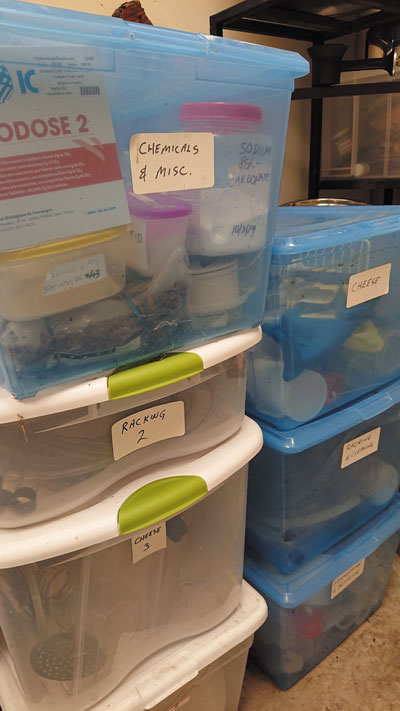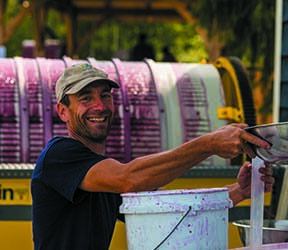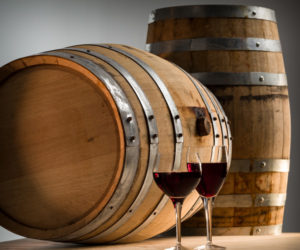When starting out, a home winemaker will typically make a list of needed supplies and visit the local home winemaking shop (or go online) and buy just what is needed for now. Make wine a few times, though, and you find that some products come up again and again, making them like staples in a kitchen pantry. This column addresses the numerous types of pantry materials, what their uses are, how much to keep on hand, storage conditions, and shelf life estimates. Cost is also considered.
Most of the time, we buy living fermentation products for a specific project. For yeast, you make a careful selection based on grape or juice variety, your fermentation conditions, and desired wine style outcome. A common rule-of-thumb for the dose of active dry wine yeast is one gram per gallon (4 L) of must or juice. I usually estimate that I get about 10 gallons (38 L) of red wine must or 6 gallons (23 L) of pressed white juice per 100 lbs. (45 kg) of fresh grapes. Dry wine yeast is sold in small packages of 5–10 g and sometimes in quarter-pound (113-g) or 500-g pouches. Once I estimate how much I need, I usually spend just a few dollars more and buy about 10% over my estimate. It doesn’t hurt to over-inoculate a bit (up to a factor of 2x has no negative effect) and you just might get more juice yield than you expected.

I keep two categories of yeast in my pantry. The first is surprise winemaking. Living as I do in Sonoma County, California, I occasionally run across unexpected grapes available during harvest season. If that happens, I like to have a great general-purpose yeast like Lalvin EC-1118 or Red Star Premier Rouge on hand. These spot projects rarely exceed about 250 lbs. (113 kg), so keeping 30 g or so of yeast on hand at a cost of about $10 is good preparation. The other on-hand purpose is the potential for a sluggish or stuck fermentation where you might have to re-inoculate. For that, I recommend another 30 g or so of a strong fermenter like EnartisFerm WS or Uvaferm 43. While your primary yeast selection is likely to be used right away, you can store these “pantry” yeasts in the fridge for at least a year. In the original bulk packages, factory shelf life estimates under good storage conditions go as long as four years. Leave your yeast in its original packaging, mark the date you bought it on the label, and carefully reseal a package if you do not use the entire amount at once.
I purchase malolactic bacteria (MLB) every year. Most red wines, plus some Chardonnays and Sauvignon Blancs, are put through malolactic fermentation (MLF) at or near the end of primary fermentation. If you have used barrels that have previously contained MLF activity, you may not need to inoculate. For the rest of us, buying freeze-dried or refrigerated liquid MLB culture are the best choices. This is one area where I do not keep any “pantry” supply. Three reasons drive my “purchase as needed” decision. First, it is easy to tell how much I will need and when because I inoculate for MLF when the wine reaches zero °Brix (about dry), so I am already observing the timing and volume. Second, these bacteria cultures are less rugged than yeast and typically have shorter shelf lives — months for the liquid cultures and a year or two for the frozen ones. Third, they are fairly expensive for the volume treated. The liquid pouches from Wyeast and White Labs each inoculate six gallons (23 L) of wine and sell for about eight to ten dollars. The freeze-dried cultures are typically packed for 66 gallons (250 L) of wine and sell for $20 to $40 per pack. Producers do not recommend keeping a partial pack. It does not hurt to use more than the recommended dose, so if a six-gallon (23-L) pack or two won’t meet your volume, go ahead and buy freeze-dried and use the whole envelope. Keep liquid culture in the fridge and freeze-dried in the freezer.
Some enzyme preparations may also be subject to shelf life concerns. These are products added at crush to improve juice yield and maceration, plus related materials added later to finished wine to aid clarification. Available as liquid solutions or as granular solids, store them in the original plastic containers. Many will be marked with a shelf life, but assume one to two years if not. Liquids must be kept in the refrigerator, but the solid products are shelf stable. Because of that difference, I prefer to keep solid materials like Lallzyme EX or Lallzyme Cuvée Blanc on hand in case more grapes or an unexpected project come up. Since you only need 10 g per 1,000 lbs. (450 kg) of grapes and they cost only about $1 per gram, it’s worth it to keep some on hand.
While your primary yeast selection is likely to be used right away, you can store these “pantry” yeasts in the fridge for at least a year.
Much more shelf stable are tannin products. Mostly derived from wood, products like FT Rouge Soft from Scott’Tan or EnartisTan Rouge are rated for storage up to five years. For red wines they can serve as “sacrificial” tannins during primary fermentation, combining with other grape components and dropping out. That process leaves more of the original grape tannins available in the wine, improving stability and providing resistance to oxidation. White wine tannin preparations are added to juice before fermentation to help minimize oxidation and improve the wine’s mouthfeel. Because they are versatile, stable, and used in small quantities, I keep both red and white tannin products on hand. Date the label and figure on a good five years of potential use. Closely related tannins for later use in fining or aging can be handled the same way.
Nutrient products like Lallemand Fermaid K or Enartis Nutriferm are also stable. Typically containing DAP (diammonium phosphate), inactivated yeast hulls, and other natural materials, they should keep at least four years in original packaging. Transferred to a plastic bag or a jar after opening, you can still expect at least a couple of years of longevity as long as conditions are cool and dry. Once again, date any containers so you will be able to consider replacement if you start pushing a three- or four-year storage period. Often added at rates of one gram per gallon (0.25 g/L) or so, a small quantity will take care of most winemaker’s needs. They are also relatively inexpensive if you need to replace your supply, coming in around 5 cents a gram, depending on formulation and package size.
Other essential products in the winemaker’s pantry are cleaners and sanitizers. Pure chemical cleaning agents like sodium percarbonate or sodium carbonate have very long shelf lives if kept sealed and dry. Plastic bags or plastic jars provide suitable containers and you will probably use up any reasonable quantity before there is any loss of effectiveness. Special purpose liquid cleaners like TDC (triple duty concentrate) from National Chemicals are also very stable and can be kept in the original bottle for as long as it takes for you to use it up. Similarly, concentrated no-rinse sanitizers like Star San and iodophor are stable for at least a year and probably longer. Because of safety warnings, do not transfer these concentrates to another container. Once diluted for use, iodophor solutions retain effectiveness for hours or days and Star San for days or a few weeks (longer if distilled water is used), but for most home winemakers they will have to be newly diluted from concentrate each time they are needed.
One particular sanitizer/preservative/wine additive deserves specific mention: Potassium metabisulfite. This essential cellar chemical is sold as a white granular material in plastic bags or jars. It has the chemical formula K2S2O5 and is sometimes compressed into Campden tablets to provide a pre-measured dose. Sulfur dioxide is constantly evolving when the powder is exposed to air and it loses strength over time. While it will not turn into something that will harm your wine, it might not be as strong as you think it is. The powder or tablets should be fine for at least a year and maybe as much as three years, stored resealed in the original package. If you do as I do and prepare a 10% solution by dissolving 100 g in 1 L of distilled water, that solution should also keep with relatively little loss for up to a year. Date the glass or plastic bottle you keep it in and replace at least once per year. If you test your wine on a regular basis it won’t matter if your additive has lost a little strength, since how it worked in your wine will be reflected in your test results.
The two natural acid products commonly used in the home winery — citric acid and tartaric acid — are stable granular solids. Use citric acid in cleaning and sanitizing and tartaric acid for wine or juice that needs acid addition. Both can be kept in bags or jars for at least two years if kept dry. You could use tartaric acid in place of citric in cleaning, but a price difference has me keeping both on hand for their particular uses. A pound (454 g) of tartaric acid retails for $10 to $12 with citric acid going for about half that.
Most testing reagents are best left in their original containers and many have an expiration date assigned by the manufacturer. Since those sometimes take the form of something like “six months from date of purchase,” mark the label with the date you got it. Especially at risk of a shorter shelf life are some of the most commonly used chemicals. pH buffers, essential for calibrating your pH meter, are prone to developing mold when stored. Refrigerated storage will help, but replace if you see any mold and at least once per year in any case. The dilute sodium hydroxide solution used for titratable acidity (TA) testing is subject to losing strength over time. Replace any 0.067 N or 0.1 N sodium hydroxide at least once per year or any time you see anything growing in it. Refrigeration helps here, too, but keep the bottle tightly closed to avoid picking up moisture from the environment and accidentally diluting your standardized reagent.







